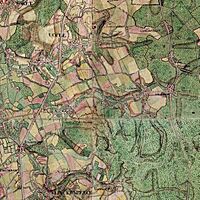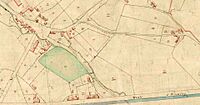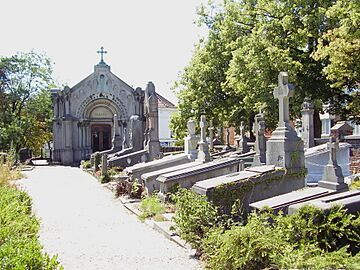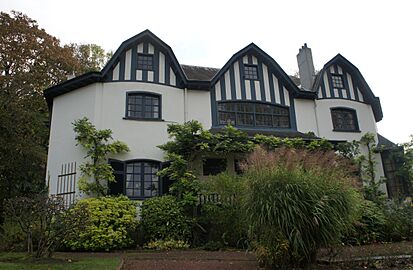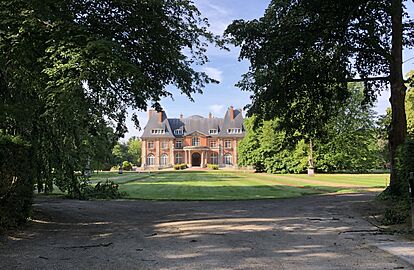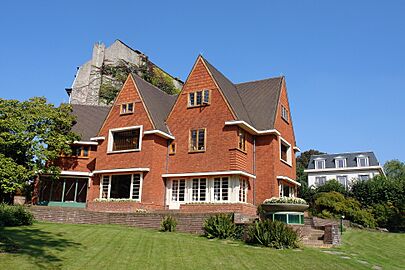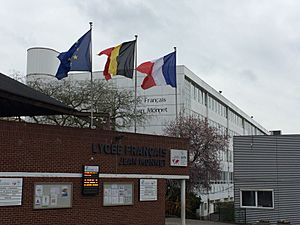Uccle facts for kids
Quick facts for kids
Uccle
|
|||
|---|---|---|---|
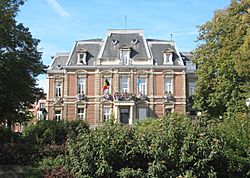
Uccle's Municipal Hall
|
|||
|
|||
| Country | Belgium | ||
| Community | Flemish Community French Community |
||
| Region | Brussels | ||
| Arrondissement | Brussels-Capital | ||
| Area | |||
| • Total | 22.91 km2 (8.85 sq mi) | ||
| Population
(2018-01-01)Lua error in Module:Wd at line 1575: attempt to index field 'wikibase' (a nil value).
|
|||
| • Total | Lua error in Module:Wd at line 1,575: attempt to index field 'wikibase' (a nil value). | ||
| Postal codes |
1180
|
||
| Area codes | 02 | ||
| Website | www.uccle.be/fr www.uccle.be/nl |
||
Uccle (pronounced yoo-kluh in French) or Ukkel (pronounced uh-kuhl in Dutch) is one of the 19 towns in the Brussels-Capital Region of Belgium. It is located in the southern part of this region. Uccle shares borders with other Brussels towns like City of Brussels, Forest, Ixelles, and Watermael-Boitsfort. It also borders some towns in the Flemish region.
Like all towns in Brussels, Uccle is officially bilingual, meaning both French and Dutch are spoken there. As of 2022, about 85,099 people live in Uccle. The town covers an area of 22.87 square kilometers (about 8.8 square miles). This makes it less crowded than the average Brussels town. Uccle is known as a wealthy area, and many French people have chosen to live there.
Contents
Discovering Uccle's Past
Early Days and Medieval Times
Legend says that Uccle's St. Peter Church was officially opened in the year 803. Important people like Pope Leo III and Charlemagne were supposedly there. Over the next few centuries, many rich families built their homes in Uccle. The name Woluesdal, which is now Wolvendael, was first mentioned in 1209.
In 1467, Isabella of Portugal, who was married to Philip the Good, Duke of Burgundy, started a Franciscan convent in Uccle. Later, Uccle became the main legal center for the area around Brussels. For a long time, Uccle was mostly a farming village. People mainly made a living from forestry and agriculture.
The Lordship of Stalle
A big part of Uccle today used to be part of a historical area called the Lordship of Stalle. This area also included the old village of Uccle. The first leaders of Stalle were knights and important officials in Brussels. One of them, Florent de Stalle, helped create the Stalle chapel.
Some smaller areas, called fiefs, were part of the Lordship of Stalle. One fief, Overhem, had a manor, a mill, and woods. Another fief, Roetaert, was located near the Kersbeek woods.
Uccle from the 1700s to Today
In the late 1700s, after the French Revolution, Uccle became its own municipality. This meant it had its own mayor and local government. In 1828, the Dutch government allowed Uccle to build its first town hall. This was a time of good economic growth for Uccle. Its location near major roads connecting Brussels to the industrial south helped a lot.
A bigger town hall was built between 1872 and 1882. A banker named Georges Brugmann helped a lot with Uccle's development around the year 1900. In the early 1900s, a new type of chicken, called the d'Uccle, was created and named after the town. Even though many new buildings went up, Uccle managed to keep many of its green spaces. These green areas now attract many wealthier people to live there.
Uccle is Brussels' largest and southernmost municipality. It is known for its large 19th and 20th-century villas with big gardens. This makes it a popular place for people from other countries to live. The Art Deco area near the Royal Observatory of Belgium is especially popular.
Exploring Uccle's Main Sights
Uccle is mostly a place where people live, but it has many beautiful parks and wooded areas. These include the Wolvendael Park and the Verrewinkel Woods. Wolvendael Park has a castle from 1763. The Place de Saint-Job and the area around St. Peter's Church are older parts of town. They are now full of shops and pubs.
Uccle is also home to Belgium's national weather station, called the Royal Meteorological Institute. This is where most of Belgium's weather information comes from. Right next door is the Royal Observatory of Belgium, which studies space.
Other interesting places to visit in Uccle include:
- Uccle Cemetery: Also known as Dieweg Cemetery, it was created after a cholera outbreak in 1866. Even though new burials stopped in 1958, you can find the grave of Hergé here. He was the famous creator of Tintin.
- The Villa Bloemenwerf: This is an Art Nouveau house built in 1895 by the architect Henry Van de Velde. It was his first home.
- The Château de La Fougeraie: This castle was built in 1911 for a businessman named Paul Wittouck.
- The Van Buuren Museum & Gardens: This used to be a private house with large gardens. Now it is a museum and park. It was built in the Art Deco style between 1924 and 1928.
- Nemo 33: This is one of the deepest indoor swimming pools in the world.
Education in Uccle
Most students in Uccle, from ages 3 to 18, go to schools run by either the French-speaking or Flemish-speaking communities. Other schools in Uccle include:
- European School, Brussels I
- Lycée Français Jean Monnet
- Collège Saint-Pierre, founded in 1905
Famous People from Uccle
- Salvatore Adamo (born 1943), a singer and writer.
- Jean Améry (1912–1978), an author.
- Sandrine Blancke (born 1978), an actress.
- Dedryck Boyata, a football player.
- Roger De Coster (born 1944), a professional motocross racer.
- Maxime De Zeeuw (born 1987), a basketball player.
- Jaco van Dormael (born 1957), a film director.
- M. C. Escher (1898–1972), a Dutch graphic artist.
- Lara Fabian (born 1970), a singer-songwriter.
- Jean-Michel Folon (1934–2005), an artist and sculptor.
- Isabelle Gatti de Gamond, an educationalist and feminist (1839–1905).
- Martin Gray (1922–2016), a writer and Holocaust survivor.
- Pierre Harmel (1911–2010), a lawyer and former Prime Minister.
- Boris Johnson, a British politician, lived here in the 1970s.
- Vincent Kompany (born 1986), a football player and manager, former captain of the Belgium national team.
- Joachim Lafosse (born 1975), a film director.
- Pierre de Maere (born 2001), a singer-songwriter.
- Princess Maria-Anunciata of Liechtenstein (born 1985).
- Princess Marie-Astrid of Liechtenstein (born 1987).
- Queen Mathilde (born 1973).
- Axel Merckx (born 1972), a professional bicycle racer.
- Erik Pevernagie (born 1939), a painter and writer.
- Henri Pirenne (1862–1935), a historian.
- Alizée Poulicek (born 1987), Miss Universe Belgium 2008.
- Joseph Raphael (1869–1950), an impressionist painter.
- Axelle Red (born 1968), a singer-songwriter.
- Georges Remi, also known as Hergé (1907–1983), the creator of The Adventures of Tintin.
- Willy Sommers (born 1952), a singer.
- Olivier Strebelle (1927–2017), a sculptor.
- Henry van de Velde (1863–1957), a painter and architect.
- Angèle Van Laeken (born 1995), a singer-songwriter.
Uccle's International Connections
Twin Towns
Uccle has a special connection with one other town:
 Neuilly-sur-Seine, France
Neuilly-sur-Seine, France
See also
 In Spanish: Uccle para niños
In Spanish: Uccle para niños





